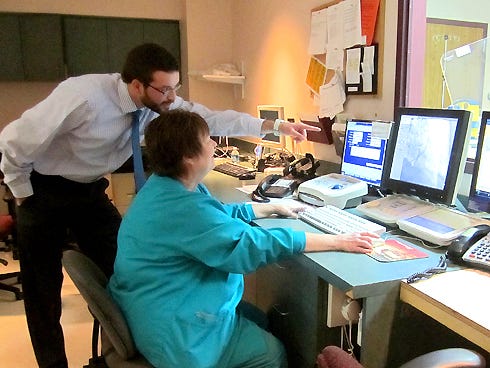
CRESTVIEW — Whether at north Okaloosa County's hospital or at Physicians Plaza, "the four-story,” healthcare here remains as personal and local as it was when brothers Dr. Justus O. and Dr. Olin Oliver Enzor opened the community's first hospital in 1926.
Today, North Okaloosa Medical Center has evolved into a modern hospital complex featuring innovative technologies found in a larger community, yet with personal care.
See "Related Media" at left for video of North Okaloosa Medical Center.
"We're caring for our neighbors," NOMC chief executive officer David Fuller said. "A hospital like this in a community like ours is not like being in Pensacola or Tallahassee or Atlanta, where the chances of bumping into one of your patients in the grocery store is slim to none.”
The hospital evaluates new equipment and technologies as they become available, Fuller said. While expense is a factor in acquiring equipment, even more important is having sufficient need for the devices.
"We're always looking at how we need to grow and what we need to expand to meet the community's needs," Fuller said. "You need to have a volume of procedures to keep your competency and quality level."
New facilities and services
The two-story Patient Tower, which opened in 2011, allows north county treatment of diseases and injuries that a few years ago required patients to travel to Fort Walton Beach, Pensacola or out of state.
Its expanded Intensive Care Unit and accompanying Step Down Unit have enhanced emergency care services. A heart catheterization laboratory, with twin labs flanking a central control room, offers services that once required sending patients by ambulance to an out-of-town facility.
The four story provides routine X-rays, lab work, physical therapy and other outpatient services through a facility that NOMC shares with Sacred Heart Medical Center of Pensacola. Primary care clinics in Baker, Crestview and DeFuniak Springs provide similar services without the time and expense of hospital admission.
The hospital’s next goal is to attain national certification for its chest pain and stroke centers to offer primary stroke and primary cardiac intervention.
"We are moving to being the place that people think about when they have a cardiac issue," Fuller said.
Linking information technologies
On the technology side, NOMC wants to corral its several computer systems into one interactive system that allows different departments and doctors to share information within the facility and at doctors' clinics, Fuller said.
"The expectation is that our information systems will communicate with the physicians' systems," he said. "That will enable them and us to provide better and more comprehensive care for their patients."
System integration will occur in phases, and that will take some time, administrators said.
"We've completed the first wave,” Fuller said. “The next wave will be linking our outpatient clinics that we offer. Likely, the third and final wave will be bringing the physician documentation into that format. Once we move them into the final phase, that record will be complete."
Building the team
Recruiting caregivers for a hospital serving a smaller community takes finesse, but yields a higher quality doctor, nurse, technician or specialist, Fuller said.
"We take a ton of time to identify the right type of players to be part of the medical staff we put together," he said.
Building a winning team in a community hospital is rewarding, Fuller said, because people who work there choose to do so.
"The people who are in a hospital like ours make a conscious decision to work in a hospital like ours," he said. "If you go to a big, big organization, people are specialists in one area. Our people serve a bigger need.
"There are a lot of misconceptions about being in a community hospital. It's a much more collegial atmosphere. It's a blessing. They back each other up to try not to put too much of a load on each other."
Plenty of recruitment time is spent attracting specialists, Fuller said, adding that staffers constantly evaluate patients’ needs and expectations of growth and demand.
The future
"People think hospitals and health care providers are somehow immune to the general swings of the economy. Beep! Wrong answer," Fuller said. "We're watching what's happening in the federal government and sequestration. The federal government pays a huge amount of health care."
There is some uncertainty surrounding the Patient Protection and Affordable Care Act that President Barack Obama signed in 2010, Fuller said.
"That being said, we're continuously looking around to see what we can do to make things better for our patients,” he said.
One such method is offering robotic surgery.
"We've got technology that we're evaluating right now to see if it makes sense in our market," Fuller said. "They have technology right now where they can make one tiny incision and do bladder repair; that sort of procedure.”
In the end, Fuller said, the community's hospital care boils down to "locally taking care of local folks.
Contact News Bulletin Staff Writer Brian Hughes at 850-682-6524 or brianh@crestviewbulletin.com. Follow him on Twitter @cnbBrian.
This article originally appeared on Crestview News Bulletin: NOMC eyes robotic surgery as it looks to future (VIDEO)
